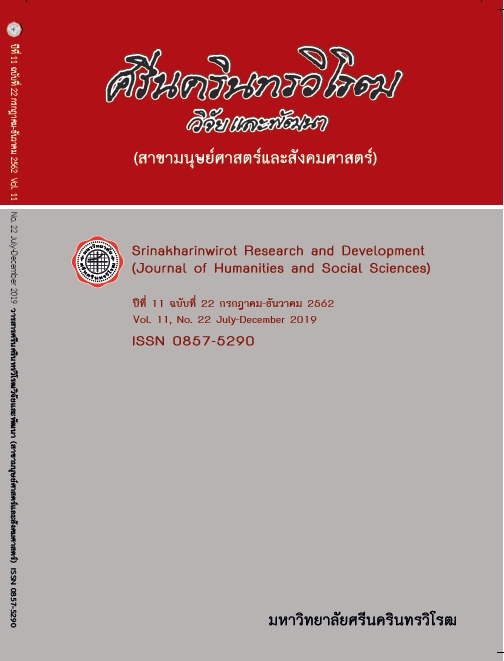การวิเคราะห์ความยากจนของผู้สูงอายุในจังหวัดเชียงราย (AN ANALYSIS OF THE POVERTY IN ELDERLY IN CHIANG RAI PROVINCE)
Keywords:
Urban and Rural, Elderly, PovertyAbstract
The objectives of this study were:1) to analyze an income and economic status and also the poverty situation of the elderly in Chiang Rai province and 2) to examine the factors affecting the poverty of the elderly in Chiang Rai province. This mixed method study recruited 526 observations for the sample group in responding to the questionnaire. The focus group discussion was conducted with the stakeholders involving in the policy and projects for the elderly in the local community. The results showed that average income per month was 5,670.25 baths and income from working was the primary source of income. However, the major of the elderly do not have saving and also not prepare before entering retirement.
The situation of poverty in the elderly indicated that the ratio of the elderly fell into poverty scale 29.47%, poverty gap 14.57%, and severe poverty 8.76%. The results also showed that the elderly in the urban area held a lower poverty level than those in a rural area. The initial elderly (60-69 yrs.) held lower poverty ratio than those in intermediate elderly (70-79 yrs.) and terminal elderly (80 yrs. and above). The male elderly held higher poverty ratio than those female elderly. The elderly living alone with grandchildren showed higher poverty ratio than the other groups. The elderly with lower education showed higher poverty ratio than those having higher education.
The analysis of factors affecting poverty by using Probit Model showed that the influential factors for poverty in the elderly were low education and lack of preparedness before retirement. The factors reducing poverty in the elderly were jobs after retirement, a number of living children, household saving, and living in urban area. The influential factors for economic inequality among the elderly were age, education, jobs after retirement, and household saving.
The guidelines reducing poverty for the elderly were jobs promotion for the elderly; lifelong education for preparedness into qualified and skilled elderhood for employability readiness to employers and entrepreneurs; preparation before entering retirement, promoting household saving, and reducing unexpected circumstances for household having the elderly. Also, the system by the government in reducing the dependent household members needs to be set up for carefully monitoring and filtering these households which are considered vulnerable to poverty.
Downloads
References
[2] คณะกรรมการปฏิรูประบบรองรับการเข้าสู่สังคมผู้สูงอายุของประเทศไทย. (2558). สรุปข้อเสนอการปฏิรูประบบเพื่อรองรับสังคมสูงวัย. สภาปฏิรูปแห่งชาติ.
[3] วรเวศม์ สุวรรณระดา, และปวีณา ลี้ตระกูล. (2557). โครงการศึกษาผลกระทบจากเบี้ยยังชีพต่อการดำรงชีวิตของผู้สูงอายุและเศรษฐกิจในระดับชุมชน. วิทยาลัยประชากรศาสตร์ จุฬาลงกรณ์มหาวิทยาลัย ได้รับทุนสนับสนุนจากสหภาพยุโรป ดำเนินงานโดยมูลนิธิพัฒนางานผู้สูงอายุ และ HelpAge International.
[4] ธนาคารโลก. (2555). การลดปัญหาความยากจนของผู้สูงอายุในประเทศไทย : บทบาทของโครงการบำนาญและความช่วยเหลือทางสังคม. กรุงเทพฯ.
[5] มนสิการ กาญนะจิตรา. (2561, เมษายน-พฤษภาคม.). ผู้สูงอายุและความยากจน. จดหมายข่าวประชากรและการพัฒนา. 38(4). สืบค้นจาก http://www.newsletter.ipsr.mahidol.ac.th/index.php/2012-11-08-03-49-15/vol38-no4/125-popdev-vol38-no4/530-2018-04-02-00-33-38.html
[6] วรเวศม์ สุวรรณระดา. (2557). การเปลี่ยนแปลงโครงสร้างประชากรกับผลกระทบต่อเศรษฐกิจและสังคม. ใน เอกสารประกอบการสัมมนา เรื่อง การเปลี่ยนแปลงโครงสร้างประชากรกับอนาคตการพัฒนาประเทศ.สำนักงานคณะกรรมการเศรษฐกิจและสังคมแห่งชาติ ร่วมกับกองทุนประชากรแห่งสหประชาชาติ (UNFPA) และสำนักงานกองทุนสนับสนุนการวิจัย.
[7] Mohd Saidatukmal. (2014). Poverty Issues among Malaysian Elderly. In Proceeding of the Social Sciences Research ICSSR 2014. (e-ISBN 978-967-11768-7-0). 9-10 June 2014, Kota Kinabalu, Sabah, Malaysia.
[8] Khan, et al. (2017). Explore the Factors that Influence Elderly Poverty. Journal of Southeast Asian Research. 2017(2017). Article ID 938459. doi:10.5171/2017.938459
[9] อานันท์ชนก สกนธวัฒนท์. (2558). ความยากจนและความเหลื่อมล้ำ. สำนักงานคณะกรรมการเศรษฐกิจ และสังคมแห่งชาติ.
[10] อิศรา ศาสติศาสน์. (2554). การวัดและการสร้างตัวแบบทางเศรษฐศาสตร์เพื่อวิเคราะห์การกระจายรายได้. คณะเศรษฐศาสตร์ จุฬาลงกรณ์มหาวิทยาลัย. กรุงเทพฯ.
[11] Cai Fang, et al. (2012). Poverty and Vulnerability among China’s Rural Elderly. 29-43. doi.org/10.1596/9780821386859_CH02
[12] Urosevic, et al. (2015). Quality of Life of the Elderly in Urban and Rural Areas in Serbia. Vojnosanitetski Pregled. 72(11): 968-974. doi:10.2298/VSP140831107U.
[13] Jensen Leif, and McLaughlin K. Diane. (1997). The Escape from Poverty among Rural and Urban Elders. The Gerontologist. 37(4), 462-468.
[14] วรเวศม์ สุวรรณระดา, และคณะ. (2561). โครงการการศึกษาสถานการณ์ปัจจุบันของการจ้างงานต่อเนื่องในสถานประกอบการและทัศนคติของนายจ้างในภาคเอกชน. มูลนิธิสถาบันวิจัยและพัฒนาผู้สูงอายุไทย (มส.ผส.).
[15] สมพร โกมารทัต, และคณะ. (2560). การสำรวจสถานะเป้าหมายการพัฒนาที่ยั่งยืนในบริบทประเทศไทย และทางเลือกมาตรการทางเศรษฐศาสตร์ สังคม และกฎหมาย เป้าหมายที่ 1 ขจัดความยากจน. ใน โครงการประสานงานการวิจัยเพื่อสนับสนุนการพัฒนาที่ยั่งยืน (SDGs). สำนักงานกองทุนสนับสนุนการวิจัย (สกว.).
Downloads
Published
How to Cite
Issue
Section
License
Srinakharinwirot Research and Development Journal of Humanities and Social Sciences is licensed Under a Creative Commons Attribution-NonCommercial-NoDerivs 4.0 International (CC-BY-NC-ND 4.0) License, Unless Otherwise Stated. Please Read Journal Policies Page for More Information on Open Access, Copyright and Permissions.



